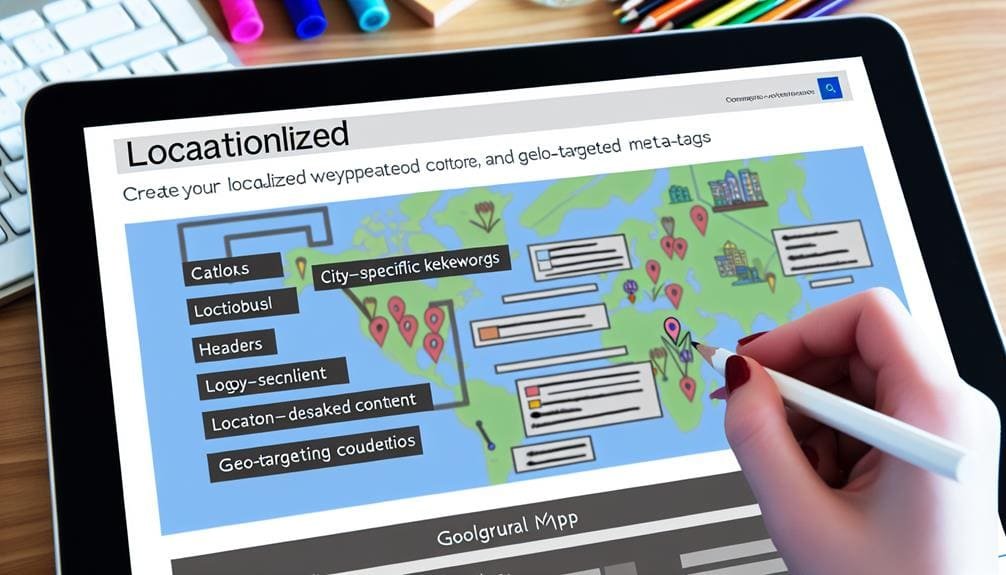Why Tailor Your SEO Strategy for Multiple Locations?
January 21, 2024 | by Jacob Cavazos

Recent studies indicate that 46% of all Google searches seek local information, underscoring the importance of a location-specific SEO strategy for businesses operating in multiple areas. As we navigate the complexities of digital marketing, we’ve recognized that a one-size-fits-all approach to SEO falls short when addressing the unique nuances of various geographical markets. To effectively capture local audiences, we must tailor our SEO strategies to resonate with consumers’ specific needs and behaviors in each location. This means optimizing our online presence to appear in local search results, where many potential customers are looking for products or services. We’ll explore the critical steps in customizing your SEO plan for every branch or outlet, from crafting location-specific content to refining local business listings, ensuring that each location stands out in its own right. Join us as we uncover the key tactics to maximize visibility, drive foot traffic, and enhance the overall performance of every location under your brand’s umbrella.
Understanding Local SEO Significance
Recognizing the importance of Local SEO, we see that optimizing for multiple locations is critical to driving targeted traffic and increasing sales in each area. A robust local SEO strategy for multiple sites isn’t just about visibility; it’s about connecting with local customers where they are actively searching. High local SEO ranking for relevant search phrases across different areas enhances in-person traffic and boosts overall brand awareness.
We meticulously create and manage individual Google My Business listings for each location to ensure potential customers use search engines to find our services. This step is non-negotiable; it’s the linchpin in helping our business appear in local search results. Consistent NAP (Name, Address, Phone number) information across these listings is fundamental to avoid confusing our audience and search engines.
Moreover, we craft location pages with local relevance in mind, integrating location-specific keywords that resonate with the community. Structured data and local citations are strategically implemented to give each site an authoritative edge. By tailoring content to reflect the nuances of the local clientele, we improve our online visibility and significantly increase the likelihood of converting searches to sales.
Website Structure for Multiple Locations

Building on our established local SEO foundations, we must now focus on crafting a website structure that effectively caters to each of our multiple locations. To achieve this, let’s consider a strategic approach to website design that aligns with multiple location SEO best practices.
To ensure we’re on the right path, we should:
- Create Unique Content for Each Location Page: It’s not enough to duplicate content across pages for each location. We need to create unique content that resonates with the local audience, incorporating local keywords and addressing the specifics of each area.
- Optimize Each Location’s URL Structure: Including the location in the URL structure enhances the relevancy for local searches. This step is crucial in signaling search engines that we have dedicated location-specific pages.
- Design a User-Friendly Website Architecture: Ensure visitors and search engines can navigate quickly to the page for each location. A clear hierarchy allows for better indexing and user experience, which is pivotal for local search visibility.
Optimizing Google Business Profiles

To maximize local search visibility, we must diligently optimize a Google Business Profile for each location. Maintaining consistent and accurate NAP (name, address, phone number) information across all location-specific Google Business Profiles is imperative. This uniformity bolsters our local SEO efforts and ensures that our local business listings are reliable for customers searching for our services.
Incorporating structured data into our GBP listings aids search engines in interpreting our business information accurately, enhancing our visibility in the local pack. This attention to detail is a cornerstone of multiple-location SEO.
Furthermore, using Google posts within our GBP allows us to engage with our patrons and share compelling offers. This level of interaction fosters loyalty and signals to Google that our business is active and relevant, positively influencing our local search rankings.
Encouraging customer reviews and responding professionally to all feedback showcases our commitment to customer satisfaction. This practice not only improves our online reputation but also contributes to the authenticity and trustworthiness of our brand.
Enhancing Local Content Strategy

After optimizing our Google Business Profiles, we’ll focus on creating and refining location-specific content to enhance our local SEO strategy. A robust regional content strategy is pivotal for businesses that serve multiple locations. It’s about more than just visibility; it’s about connecting with our target audience meaningfully.
Here’s how we’re enhancing local content for each city:
- Develop Unique Content: We’ll craft unique content for each location page, ensuring it resonates with the local audience. This includes details about local services, community involvement, and location-specific offers.
- Optimize with Local Keywords: Each piece of content will be optimized with relevant local keywords related to our business. We’ll conduct thorough keyword research to discover what our target audience is searching for in each area.
- Update Regularly: We’ll keep our content fresh and updated to maintain relevance and ranking. This means revisiting our location pages regularly to ensure accuracy, especially for any changes in services or local events.
Managing Multi-Location Online Reviews

Harnessing the power of online reviews, we can significantly enhance the visibility and credibility of our multiple locations by encouraging satisfied customers to share their positive experiences. By actively prompting customers to leave reviews on platforms such as Google Business, we foster local backlinks and make it easy for search engines to validate our local businesses.
Responding to positive and negative reviews shows that we value customer feedback, which can improve search results and a stronger rapport with our clientele. It’s crucial to manage these online reviews effectively across all locations, ensuring that the Name, Address, and Phone (NAP) information is consistent in local directories to maintain search engine trust.
| Action Item | Impact on SEO |
|---|---|
| Encourage reviews for each location | Boosts individual location visibility |
| Professional responses to feedback | Enhances credibility and engagement |
| Monitor review quality and frequency | Gains insights for experience improvement |
| Consistent NAP on review platforms | Strengthens search engine confidence |
Frequently Asked Questions
How Do I Target Multiple Locations in SEO?
We’re targeting multiple locations in SEO by creating area pages with local keywords, adding location schema, and writing regional blogging content. We also use hreflang tags for multiregional content and market segmentation strategies.
How Do I Target Multiple Cities Without Hurting My SEO?
We’ve found that incorporating local keywords and creating city-specific landing pages with geo-targeting techniques boost SEO. Using multiregional URLs and content customization aligns with search intent, while directory listings amplify location signals.
How Important Is Location for SEO?
Location is crucial for SEO as it influences local algorithms, proximity factors, and area-based ranking. We’ll optimize with city-specific keywords and localized content to meet searcher intent and address market differences effectively.
How Often Should You Adjust Sites for SEO Optimization?
We should adjust our sites for SEO optimization monthly, focusing on keyword research, content customization, and mobile optimization. This includes refining site structure, managing local listings, and enhancing user experience through internal linking and social signals.
RELATED POSTS
View all



